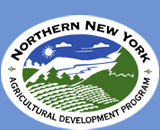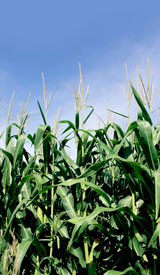June 30, 2008
Contact: Joe Lawrence, Cornell Cooperative Extension of Lewis County,
315-376-5270; Dr. Quirine M. Ketterings, Cornell University,
607-255-3061; or your local Extension office
New Calculating Tool Helps Farmers Figure Fertilizer Needs, Can Save
Money
Crop consultants and agricultural educators have begun using a new tool
now available commercially to help farmers measure soil nitrogen (N)
supply for corn crops. Cornell University researchers, Cornell
Cooperative Extension educators and Northern New York farmers are part
of a team calibrating and evaluating the Illinois Soil Nitrogen Test (ISNT)
for use in New York. 2008 is the first year the tool has been
commercially available for use on farms.
�We wanted a tool that is calibrated for New York growing conditions and
that can be used to identify if soil organic N supply is sufficient to
meet the crop�s need without additional nitrogen application, so that
farmers can avoid paying for unnecessary N. The ISNT supports better use
of on-farm manure resources and reduces the chances of over applying
nitrogen thus saving farmers some fertilizer costs,� says Cornell
Cooperative Extension of Lewis County Field Crops Educator Joe Lawrence,
who worked on the ISNT evaluation as a graduate student at Cornell
University.
The ISNT identifies readily mineralizable soil organic nitrogen (N),
organic matter and ammonium-N. Lawrence says the research team is
eagerly awaiting to compare corn yield reports from the farms trying the
ISNT for the first-time this year with the results of research trials
since 2002.
Quirine M. Ketterings, Cornell Associate Professor of Nutrient
Management and Cornell Nutrient Management Spear Program leader, says,
�The results of the first field trials in 2002, 2003 and 2004 showed
that in combination with Loss-on-Ignition (LOI) organic matter testing,
the ISNT could be used to predict if extra nitrogen is needed.�
The initial ISNT calibration was based on 33 field trials performed over
a three-year period on soils representative of some of New York�s major
agricultural regions, including Northern New York. In 2005, 2006, and
2007, another 34 research trials were conducted on New York farms to
evaluate the use of ISNT and the response of corn to nitrogen
applications based on the test.
Lawrence says, �The research trials on first-year corn grown after sod
at 16 sites showed no need to use the ISNT as the sod and 20-30 lbs of
nitrogen applied as starter fertilizer met the crop�s N need at each
site. For the remaining 18 sites with corn-after-corn and
corn-after-soybeans trials, this new test proved to be a more convenient
and more accurate way to fine-tune corn nitrogen management on a
field-by-field basis than any other tool.�
Fifteen sites were accurately predicted by the ISNT as responsive or
nonresponsive to N application.
Certified Crops Advisor Peg Cook of Cooks Consulting in Lewis County is
working with a local farm that is participating with on-farm ISNT
testing overseen by Lawrence and Ketterings.
�I am excited to see how the research pans out for the farms. The ISNT
test looks as if it could be another resource management tool that can
be used for fine-tuning nitrogen and manure recommendations. This is
important economically and environmentally and help reduce nitrate loss
to groundwater and save farmers hundreds of dollars on fertilizer
costs,� Cook says.
ISNT Preferred Over PSNT
The ISNT is preferred over the Pre-Sidedress Nitrogen Test (PSNT)
because results remain stable for two to three years, samples can be
taken over shallower depth (8 inches compared to
12 inches for the PSNT), and ISNT sample timing is not as restrictive
for the ISNT as it is for the PSNT.
Research showed that ISNT samples can be taken anytime with the
exception of within five weeks of manure applications, after killing a
sod crop by tillage or herbicide, and after adding fertilizer
ammonium-containing fertilizer � all of which affect ammonium levels in
the soil and result in artificially high estimates of N supply from soil
organic matter.
Farmers interested in learning more about the ISNT will find Cornell
Nutrient Management Spear Program Fact Sheets accessible via the
Northern New York Agricultural Development Program website in the Crops
section at www.nnyagdev.org. Agronomy Fact Sheet #35 Nitrogen Guidelines
for Corn explains how N recommendations are derived. Agronomy Fact Sheet
#36 Illinois Soil Nitrogen Test for Corn provides details on how to use
the ISNT. Agronomy Fact Sheet #4 Nitrogen Credits from Manure details
how to deduct manure N credits from the N application recommendations.
Lawrence cautions those using the ISNT about the need to know the
process used to test soil samples in the laboratory. The Cornell
Nutrient Analysis Laboratory uses an LOI procedure that burns off the
organic matter in soil samples at a high temperature to provide a
measure of the percent of organic matter.
Lawrence says, �Organic matter results obtained from a testing lab using
a different process or a similar process at different temperatures
cannot accurately be applied to the Cornell guidelines for the ISNT.
He notes that other factors that should also be considered in developing
an on-farm nitrogen application plan include soil type, weather
conditions, and pH levels of each field.
�Complex interactions affect how a field and crop use nutrients. During
times of drought, for example, applying extra nitrogen may not provide
any value to a crop even if the crop has low soil N levels. Low pH level
is another situation where adding extra fertilizer is not likely to
result in a crop yield response,� Lawrence says.
The team continues to work with Northern New York farmers in the six
northernmost counties of the state to evaluate fields for ISNT and soil
fertility. In collaboration with the farmers, Cornell Cooperative
Extension, private consultants, and the Cornell Nutrient Analysis
Laboratory, the researchers are evaluating six farms in 2008 to
determine which fields need extra N and which do not. The team also
wants to determine the impact of ISNT-based N management on fertilizer
costs and whole farm nitrogen balances.
Forms for submitting soil samples for ISNT evaluation are online at
http://cnal.cals.cornell.edu/forms/SubmissionForms.aspx. Testing
costs $15 per sample for ISNT and LOI; $10 when the ISNT is added as an
extra test to the standard soil fertility testing package. Additional
information on corn nitrogen needs is found on the Northern New York
Agricultural Development Program website at
www.nnyagdev.org. Other useful
resources are available through the Cornell Nutrient Management Spear
Program website at
http://nmsp.css.cornell.edu/.
The Northern New York Agricultural Development Program, New York Farm
Viability Institute, and Cornell University funded the research to
improve crop nutrient management for New York farmers. # # #



